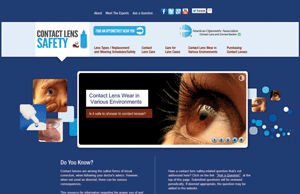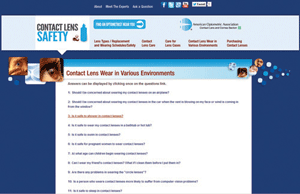What is the “healthiest” contact lens type?
Is it OK if I simply replace my lenses when they start to bother me, rather than when my doctor said I should?
What should I do if I drop my contact lens on the floor?
These are but a few of the common questions on the minds of your contact lens patients. Although we would hope that patients would turn to us, their eye care providers, for answers, the reality is that their first source tends to be the internet more often than not.
Unfortunately, many of the health care websites that consumers frequently visit for answers are simply places where other consumers chime in with highly opinioned responses, unsupported by any scientific evidence or references. Their “expertise” is usually derived only from their own experiences as a contact lens wearer.
This reliance on non-professional opinions degrades the public’s knowledge of safe lens wear and care practices, and can lead to further complications in contact lens safety.

1. The ContactLensSafety.org homepage.
If you find this troubling, here’s good news. An authoritative online resource for consumers, media and even eye care professionals, has been developed by the American Optometric Association’s Contact Lens and Cornea Section, in cooperation with the American Academy of Optometry’s Section on Cornea, Contact Lenses and Refractive Technologies.
As one of its developers, I’d like to share with you some details on how it works.
Safety’s Missing Piece
It is the mission of every contact lens fitter to provide patients with crisp vision, good comfort and a safe wearing experience. We have made great strides in improving lens safety by developing ever-improving materials, modalities and care systems. But all this progress quickly falls apart if the patient does not properly wear or care for their lenses.
ContactLensSafety.org was developed to provide patients with a high-quality resource for contact lens-related information outside of the clinician’s office. The hope is that this resource will translate into improved habits and safer contact lens wear. Every answer on the website is properly referenced, so eye care practitioners can refer patients, and the public, to the site with confidence.
ContactLensSafety.org is rapidly becoming a definitive online source for information on a number of subjects, ranging from proper contact lens care and lens case care to the dangers posed by illegal cosmetic lenses.
During just the first quarter of 2013, more than 4,000 unique visitors turned to
ContactLensSafety.org for reliable, referenced information on contact lenses.
Site Layout
The site offers several ready answers, in easy-to-understand layman’s terms, to what are thought to be 50 of the most commonly asked contact lens-related questions.
The questions are categorized under one of the following topic headings:
• Lens Types/Replacement and Wearing Schedules/Safety
• Contact Lens Care
• Care for Lens Cases
• Contact Lens Wear in Various Environments
• Purchasing Contact Lenses
Figure 1 shows how these headings are organized and displayed on the
ContactLensSafety.org home page. The box in the center features a revolving series of images that represent each of these five main topic headings. One accesses the questions under each heading by simply clicking on the heading title.
Once the section of the chosen topic area is entered, a list of the most commonly asked questions relating to the area chosen will be displayed. Clicking on the text of the question reveals the answer to any given question. When the cursor is properly placed, the text will become underlined and change color (see Figure 2).

2. Question display in a given topic area with one highlighted by the cursor.
In contrast to many of the resources online offering contact lens wearers information on safety, all of the answers on the site are supported by referenced sources. The details of each reference can be viewed by simply placing the cursor over the reference number. To return to the home page, users can click on “Contact Lens Safety” in the upper left corner of the page.
The top of each page provides visitors with the ability to search for an optometrist, connect to AOA’s social media accounts—such as Facebook and Twitter—and introduces the experts instrumental in developing the site: Christine Sindt, OD, Loretta Szczotka-Flynn, OD, PhD, Edward S. Bennett, OD, MSEd, and Thomas G. Quinn, OD, MS.
Consumer Interest
Thus far, the most commonly clicked-on question has been, “How should I clean my contact lens case?” (see sidebar, “Public Inquiry #1” for the answer provided on the site). In fact, of the top 10 questions clicked on by visitors to the site, six fall under the topic area of “Care for Lens Cases.”
Surprised? This can perhaps be explained by understanding that, of the top 10 Google searches that resulted in clicks to
ContactLensSafety.org, four were related to case care or lens storage. Most of the others had “safe” or “safety” in the search query.
Clearly, eye care providers may want to consider devoting more time to the topic of proper lens case care. Improved patient compliance begins with being educated on proper wear and safety, and it is our duty to impart this knowledge on our patients. It is made clear through the most popular topics on the website that we need to do a better job explaining proper lens case care.
The second most commonly explored area by site visitors concerns the topic of wearing contact lenses in various environments, such as while flying in an airplane, taking a shower or napping. While on the site, go to the “Contact Lens Wear in Various Environments” tab for answers to these questions.
“Ask a Question” Feature
If a visitor to the website does not find their question listed, they have the option of submitting it for review by clicking on “Ask a Question,” displayed at the top-center of every page. Those who do so receive an email response based on referenced sources.
To date, the majority of submitted questions relate to general safety issues. Are contact lenses safe? Are they safe in my prescription? At what age is it safe to begin wear? In many cases, such as with this last question, the submitter can simply be directed to a certain area of the website for the answer (go to Contact Lens Wear in Various Environments, Question 7).
Some questions that are repeatedly asked via the “Ask a Question” system have been, or will be, added to the website. An excellent example is the question inquiring about the safety of wearing contact lenses in an industrial environment.
Public Inquiry #1
The most popular question on
ContactLensSafety.org, based on number of clicks from users, is “How
should I clean my contact lens case?” Below is the answer provided on
the site:
To reduce the chances of infection or inflammation, immediately
after lenses are removed, discard the old solution from the wells of the
case. Then rub the case with clean fingers for at least five seconds,
rinse with contact lens disinfection solution, then wipe dry with a
clean cloth.1
Avoid washing the case with tap water as this has been
linked with increasing the risk of developing Acanthamoeba keratitis, a
severe corneal infection, resistant to treatment and cure, that can lead
to permanent vision loss.2
Questions on Lens Care
A number of user-submitted questions relate to contact lens care. A common one has been, “Is it OK to use expired solution?” The simple answer to this question is no. For a more complete, referenced response, which includes an informative discussion of the concept of discard dates, please click on question 3 under the Contact Lens Care heading.
Handling Issues
Many consumers have asked for advice on how to determine whether or not a soft contact lens is being worn inside out. Make sure this is an area you or your staff covers at any new dispensing visit. Asking your patients to demonstrate the employment of these techniques is an excellent way of ensuring your patients are exercising proper compliance.
It is possible that some site visitors may be posing this question because they have purchased illegal cosmetic lenses from an unauthorized source, and have therefore received no training in proper lens care or handling.
Recognizing this, each response to this question has encouraged patients to consult with a local eye care provider for proper instructions, and explains the importance of having contact lens fitting and follow-up services provided by a qualified professional.
How You Can Use
ContactLensSafety.org?
When you talk to your patients about the importance of proper lens wear, care and handling for a safe contact lens wearing experience, provide them with a flier directing them to
ContactLensSafety.org.
Fliers can be printed by visiting
www.aoa.org/Documents/optometrists/clcs-contact-lens-safety-flyer.pdf. Some offices routinely provide the flier to all patients at their contact lens care and handling training visit. It’s a good habit to get into as a means of opening a dialogue with patients about proper lens care.
In addition to assisting your patients,
ContactLensSafety.org can also be a great resource for you! Go to the site yourself to get ideas on how to answer what can sometimes be tricky questions, knowing your responses will be backed by science. Not only will the site help you answer these difficult questions, but it can also be useful in understanding what aspects of contact lens wear patients need the most guidance. This will allow you to be better prepared to educate your patients on these topics during visits.
Visiting the site periodically will prove to benefit both you and your practice.
ContactLensSafety.org is a living resource, with unlisted questions being added, and ignored questions deleted. The site depends on what consumers, and you, want to know about contact lenses and how to wear them safely.
The author wishes to thank Capucine Chatman-Willams and Jon Schwab for their assistance in gathering statistics for this article.
1. Wu YT, Zhu H, Willcox M, Stapleton F. Removal of biofilm from contact lens storage cases. Invest Ophthalmol Vis Sci. 2010 Dec;51(12):6329-33. Epub 2010 Aug 18.
2. Mutoh T, Ishikawa I, Matsumoto Y, Chikuda M. A retrospective study of nine cases of Acanthamoeba keratitis. Clin. Ophthalmol. 2010;21(4):11890-92.


